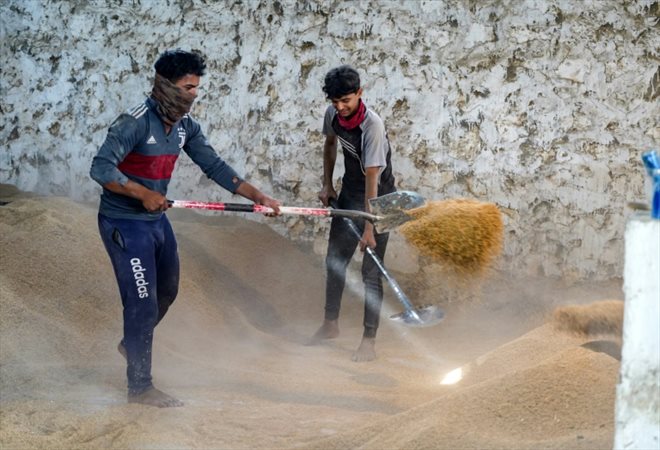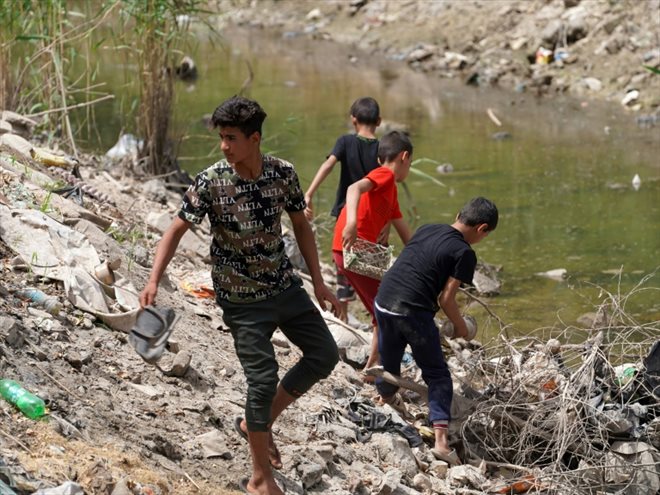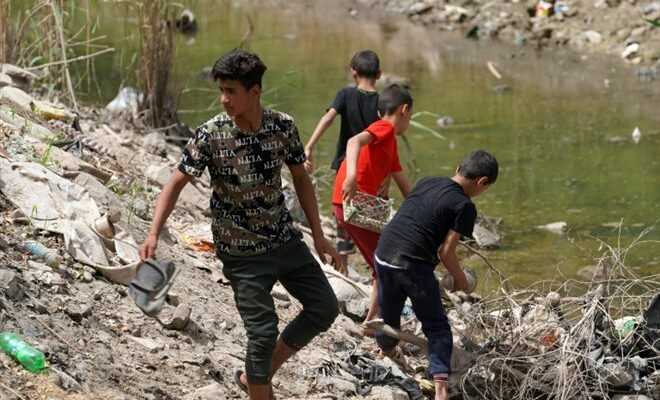A worker at a rice mill in Najaf, central Iraq, on May 1, 2022 (AFP/Qassem al-KAABI)
It is a variety of flavored rice used in Iraq to prepare traditional dishes. But in a country hit by drought and a drastic drop in water reserves, amber rice is struggling to survive.
“Since I was a child, I have been planting amber rice,” says Abou Rassoul, near an almost dried up ditch, normally irrigating his two hectares of land in the central province of Najaf, near the village of Al- Abassiya.
“It is with water that we can plant each year (…) We live from this land”, pleads the farmer with a weathered face.
After three years of drought and a drop in rainfall, this season the cultivation of amber rice, which takes its name from its aroma, similar to that of amber resin, will be symbolic.
In principle, fields planted from mid-May must remain submerged all summer. A luxury that Iraq can no longer afford.
The country’s available water reserves are currently “well below our critical threshold of 18 billion cubic meters”, Najaf’s water resources manager, Chaker Fayez Kadhim, told AFP.

Iraqi farmer Abu Rasul walking in a field near the village of Al-Abbassiya on May 1, 2022 (AFP/Qassem al-KAABI)
However, the rice fields drain between 10 and 12 billion cubic meters of water during the cultivation period until the harvest in October, he underlines. “Difficult to grow rice in Najaf or other provinces, due to high water consumption.”
Previously, more than 70% of amber rice was grown in Diwaniyah and neighboring Najaf provinces.
At the beginning of May, the authorities limited the areas for cultivation: only 10,000 donums of rice (one thousand hectares) will be grown there, according to the Ministry of Agriculture, against 350,000 donums in normal times.
– Threatened with disappearance –
Consumers will have to resort to imported varieties to prepare the traditional Qouzi, mutton served with rice, or mansaf and dolmas, stuffed vegetables.
Iraq produced up to 300,000 tonnes of rice annually, according to Mohamed Chasseb, a senior official in the planning department of the Ministry of Agriculture.
Nicknamed in Arabic the “country of two rivers” – the Tigris and the Euphrates – Iraq has seen its water resources diminish for years. Baghdad continues to denounce its neighbours, Turkey and Iran in the lead, who are building dams upstream and reducing the flow.

Workers shoveling at a rice mill in Najaf, central Iraq, on May 1, 2022 (AFP/Qassem al-KAABI)
That of the Euphrates currently represents 30% of what it was in normal times, according to Mr. Khadim, who calls for “political action”.
“There is a risk of seeing rice cultivation disappear due to the lack of water”, warns the president of the peasant associations of Najaf, Ahmed Hassoun.
The 51-year-old agricultural engineer castigates the responsibility of the authorities: “We know that Iraq will be deprived of rains in the years to come”. Despite this, nothing has been done to “modernize the irrigation systems”.
“The government has nothing to do with agriculture. It has transformed Iraq into a market for all the neighboring countries”, regrets Mr. Hassoun, in reference to the agricultural imports, Iranian and Turkish in particular, which are flooding Iraq.
– “Breadwinner” –
In 2021, the World Bank recorded a 17.5% contraction in agricultural activity in Iraq, after in particular “severe droughts”.
The stakes are high for this country ultra-dependent on oil revenues which wants to diversify its economy: agriculture represents 20% of jobs and is the second largest contributor to GDP (5%), immediately behind oil.
“What we want is for the state to take an interest in farmers,” testifies Jassem Zaher in Najaf, denouncing in particular the delays in payments when the state is the buyer.
The sexagenarian also cultivates amber rice: “We don’t have any other crops, it’s the peasant’s livelihood”.
This year, a ton of rice is sold by farmers to the Ministry of Commerce for 750,000 Iraqi dinars, or $500 a ton.

Young Iraqis on the banks of a polluted and dried up river in Najaf on May 1, 2022 (AFP/Qassem al-KAABI)
In addition to farmers, an entire ecosystem is threatened.
There are in particular the dozens of small traditional workshops, the “majracha”, where the rice is sorted and purified before being marketed.
In the workshop of Adel al-Haj Ghafel in Najaf, two workers armed with shovels work barefoot in the middle of mounds of rice. The grains are poured into large metal containers and pass through several sieves to remove any impurities.
“We are totally dependent on farmers,” says the forty-year-old who inherited his business from his father.
He sums up simply: “If there is no cultivation, we will close the workshops and wait until next year, with the hope that they will plant.”
© 2022 AFP
Did you like this article ? Share it with your friends with the buttons below.




